 W
WDuring World War II, the Germans' combined armed forces committed systematic war crimes, including massacres, mass rape, looting, the exploitation of forced labor, the murder of three million Soviet prisoners of war, and participated in the extermination of Jews. While the Nazi Party's own SS forces of Nazi Germany was the organization most responsible for the genocidal killing of the Holocaust, the regular armed forces of the Wehrmacht committed many war crimes of their own, particularly on the Eastern Front in the war against the Soviet Union. According to a study by Alex J. Kay and David Stahel, the majority of the Wehrmacht soldiers deployed to the Soviet Union participated in war crimes.
 W
WThe 1st Parachute Division was an elite German military parachute-landing division that fought during World War II. A division of paratroopers was termed a Fallschirmjäger Division. For reasons of secrecy, it was originally raised as the 7th Air Division, or Flieger-Division, before being renamed and reorganized as the 1st Parachute Division in 1943.
 W
WThe 2nd Parachute Division was an elite airborne division of German Wehrmacht (Luftwaffe) during World War II.
 W
WThe 4th Parachute Division,, was a divisional-sized elite formation in the Luftwaffe during World War II.
 W
WThe 22nd Infantry Division was a specialized German infantry division in World War II. Its primary method of transportation was gliders. The division played a significant role in the development of modern day air assault operations.
 W
WThe 35th Infantry Division was a German Army infantry division in World War II.
 W
W117th Jäger Division was a German infantry division of World War II. The division was formed in April 1943 by the reorganization and redesignation of the 717th Infantry Division. The 717th Division had been formed in April 1941. It was transferred to Yugoslavia in May 1941, to conduct anti partisan and Internal security operations.
 W
WThe 201st Security Division, originally the 201st Security Brigade, was a German Army rear-area security division of World War II. The unit was deployed in German-occupied areas of the Soviet Union, and was responsible for large-scale war crimes and atrocities including the deaths of thousands of Soviet civilians. It was disbanded in January 1945
 W
WThe 213th Security Division, initially known as the 213th Infantry Division, was a rear-security division in the Wehrmacht of Nazi Germany. The unit was deployed in German-occupied areas of the Soviet Union, in the Army Group South Rear Area.
 W
WThe massacre of the Acqui Division, also known as the Cephalonia massacre, was the mass execution of the men of the Italian 33rd Infantry Division Acqui by the Germans on the island of Cephalonia, Greece, in September 1943, following the Italian armistice during the Second World War. About 5,000 soldiers were massacred and others drowned.
 W
WThe Razing of Anogeia or the Holocaust of Anogeia refers to the complete destruction of the village of Anogeia in central Crete (Greece) and the murder of about 25 of its inhabitants on 13 August 1944 by German occupying forces during World War II. This was the third time Anogeia was destroyed, as the Ottomans had destroyed it twice; first in July 1822 and again in November 1867, during the Great Cretan Revolt.
 W
WArmy Group Centre Rear Area was one of the three Army Group Rear Area Commands, established during the 1941 German invasion of the Soviet Union. Initially commanded by General Max von Schenckendorff, it was an area of military jurisdiction behind Wehrmacht's Army Group Centre.
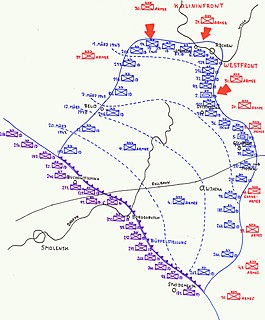 W
WOperation Büffel ("Buffalo") was a series of local retreats conducted by the German Army Group Centre on the Eastern Front during the period 1–22 March 1943. This movement eliminated the Rzhev Salient and shortened the front by 230 miles (370 km), releasing twenty-one divisions. The withdrawals were accompanied by a ruthless security campaign, resulting in widespread destruction, deportation of the able-bodied population for slave labour, and killings of civilians.
 W
WThe Caiazzo massacre was the massacre of 22 Italian civilians at Caiazzo, Campania, Southern Italy, on 13 October 1943, during World War II by members of the German 3rd Panzergrenadier Division. The massacre was described as having been of a particularly brutal nature and its leader, Lieutenant Wolfgang Lehnigk-Emden, was soon after captured by Allied forces. Lehnigk-Emden confessed to part of the crime but was later accidentally released and, for the next four decades, was not put on trial.
 W
WThe Commissar Order was an order issued by the German High Command (OKW) on 6 June 1941 before Operation Barbarossa. Its official name was Guidelines for the Treatment of Political Commissars. It instructed the Wehrmacht that any Soviet political commissar identified among captured troops be summarily executed as a purported enforcer of the "Judeo-Bolshevism" ideology in military forces. It is one of a series of criminal orders issued by the leadership.
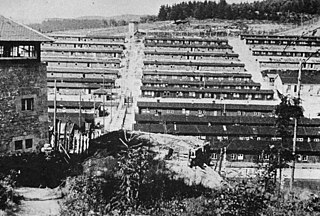 W
WFlossenbürg was a Nazi concentration camp built in May 1938 by the SS Main Economic and Administrative Office. Unlike other concentration camps, it was located in a remote area, in the Fichtel Mountains of Bavaria, adjacent to the town of Flossenbürg and near the German border with Czechoslovakia. The camp's initial purpose was to exploit the forced labor of prisoners for the production of granite for Nazi architecture. In 1943, the bulk of prisoners switched to producing Messerschmitt Bf 109 fighter planes and other armaments for Germany's war effort. Although originally intended for "criminal" and "asocial" prisoners, after Germany's invasion of the Soviet Union, the camp's numbers swelled with political prisoners from outside of Germany. It also developed an extensive subcamp system that eventually outgrew the main camp.
 W
WThousands of Jews lived in the towns of Dęblin and Irena in central Poland before World War II; Irena was the site of the Polish Air Force Academy from 1927. In September 1939, the town was captured during the German invasion of Poland and the persecution of Jews began with drafts into forced labor and the establishment of a Judenrat. A ghetto was established in Irena in November 1940. It initially consisted of six streets and was an open ghetto. Many ghetto inhabitants worked on labor projects for Dęblin Fortress, the railway, and the Luftwaffe. Beginning in May 1941, Jews were sent to labor camps around Dęblin from the Opole and Warsaw ghettos. Conditions in the ghetto worsened in late 1941 due to increased German restrictions on ghetto inhabitants and epidemics of typhus and dysentery.
 W
WHitler’s Bandit Hunters: The SS and the Nazi Occupation of Europe is a 2006 book by the British author and researcher Philip W. Blood. It discusses the evolution of German rear security policies during World War II, from Partisanenkreig to Bandenbekämpfung, leading to mass crimes against humanity and genocide.
 W
WThe Jägerstab was a Nazi German governmental task force whose aim was to increase production of fighter aircraft during World War II. Established in March 1944, it was composed of government and SS personnel, as well as representatives of the aircraft manufacturers. The task force played a key role in the Emergency Fighter Program, including the "people's fighter" Heinkel He 162.
 W
WThe Kalavryta massacre, or the Holocaust of Kalavryta, refers to the near-extermination of the male population and the total destruction of the town of Kalavryta, Greece, by the 117th Jäger Division (Wehrmacht) during World War II, on 13 December 1943.
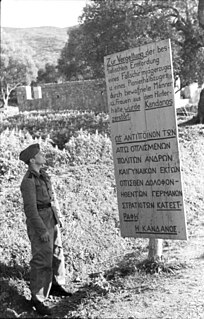 W
WThe Razing of Kandanos refers to the complete destruction of the village of Kandanos in Western Crete (Greece) and the killing of about 180 of its inhabitants on 3 June 1941 by German occupying forces during World War II.
 W
WKaufering was a system of eleven subcamps of the Dachau concentration camp located around the town of Landsberg am Lech in Bavaria, which operated between 18 June 1944 and 27 April 1945. Previously, Nazi Germany had deported all Jews from the Reich, but having exhausted other sources of labor, Jews were deported to Kaufering to create three massive underground bunkers, Weingut II, Diana II, and Walnuss II, which would not be vulnerable to the Allied bombing which had devastated German aircraft factories. The bunkers were intended for the production of Messerschmitt Me 262 aircraft, but none were produced at the camps before the United States Army captured the area.
 W
WThe Massacre of Kondomari was the execution of male civilians from the village of Kondomari in Crete by an ad hoc firing squad consisting of German paratroopers on 2 June 1941 during World War II. The shooting was the first of a series of reprisals in Crete. It was orchestrated by Generaloberst Kurt Student, in retaliation for the participation of Cretans in the Battle of Crete which had ended with the surrender of the island two days earlier. The massacre was photographed by Franz-Peter Weixler, a German army war propaganda correspondent, whose negatives were discovered 39 years later in the Federal German archives by a Greek journalist.
 W
WThe Massacre of Kos was a war crime perpetrated in early October 1943 by the Wehrmacht against Italian army PoWs on the Dodecanese island of Kos, then under Italian occupation. About a hundred Italian officers were shot on the commands of General Friedrich-Wilhelm Müller, after being considered traitors for resisting the German invasion of the island.
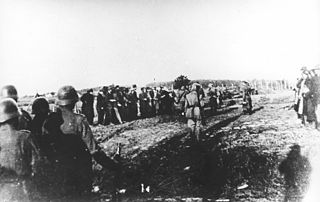 W
WThe Kragujevac massacre was the mass murder of between 2,778 and 2,794 mostly Serb men and boys in Kragujevac by German soldiers on 21 October 1941. It occurred in the German-occupied territory of Serbia during World War II, and came as a reprisal for insurgent attacks in the Gornji Milanovac district that resulted in the deaths of 10 German soldiers and the wounding of 26 others. The number of hostages to be shot was calculated as a ratio of 100 hostages executed for every German soldier killed and 50 hostages executed for every German soldier wounded, a formula devised by Adolf Hitler with the intent of suppressing anti-Nazi resistance in Eastern Europe.
 W
WThe Lingiades massacre, on 3 October 1943, was a Nazi German war crime committed by members of the 1st Mountain Division of the Wehrmacht Heer during the Axis occupation of Greece. The village of Lingiades (Λιγκιάδες), near Ioannina in northwestern Greece, was arbitrarily chosen as a target for reprisals by the Wehrmacht due to the killing of a German officer by members of the Greek Resistance. The vast majority of the victims were children, women, and elderly.
 W
WDuring World War II, the German Luftwaffe staffed dozens of concentration camps, and posted its soldiers as guards at many others. Camps created for the exploitation of forced labor for armaments production were often run by the branch of the Wehrmacht that used the products. The Wehrmacht also posted about 10,000 Wehrmacht soldiers to concentration camps because of a shortage of guards in mid-1944, including many from the Luftwaffe.
 W
WThe Luftwaffe was the aerial warfare branch of the Wehrmacht during World War II. Germany's military air arms during World War I, the Luftstreitkräfte of the Imperial Army and the Marine-Fliegerabteilung of the Imperial Navy, had been disbanded in May 1920 in accordance with the terms of the Treaty of Versailles which stated that Germany was forbidden to have any air force.
 W
WMarching into Darkness: The Wehrmacht and the Holocaust in Belarus is a book by the American historian Waitman Wade Beorn, published in 2014 by Harvard University Press. It discusses the participation of the German Wehrmacht in the Holocaust and other crimes against humanity during the course of the early stages of the German-Soviet War (1941–45).
 W
WThe Messerschmitt Bf 109 is a German World War II fighter aircraft that was, along with the Focke-Wulf Fw 190, the backbone of the Luftwaffe's fighter force. The Bf 109 first saw operational service in 1937 during the Spanish Civil War and was still in service at the dawn of the jet age at the end of World War II in 1945. It was one of the most advanced fighters when it first appeared, with an all-metal monocoque construction, a closed canopy, and retractable landing gear. It was powered by a liquid-cooled, inverted-V12 aero engine. It was called the Me 109 by Allied aircrew and some German aces, even though this was not the official German designation.
 W
WThe Minsk Trial was a war crimes trial held in front of a Soviet military tribunal in 1946 in Minsk, the capital of Soviet Belarus. Defendants included German military, police, and SS officials who were responsible for implementing the occupational policies in Belarus during the German–Soviet War of 1941–45.
 W
WOperation Bamberg was an Nazi security warfare operation during the Occupation of Belarus by Nazi Germany. The pilot project for offensive "anti-partisan" fighting was the operation Bamberg in the area of Hlusk District-Pariczi-Oktiabrskij to the south of Bobrujsk, in the eastern Polesie.
 W
WThe Padule di Fucecchio massacre was the murder of at least 174 Italian civilians, carried out by the 26th Panzer Division at Padule di Fucecchio, a large wetland north of Fucecchio, Tuscany, on 23 August 1944. After the war, the commander of the 26th Panzer Division was sentenced for war crimes, but the men who carried out the massacre were not convicted until 2011 and none served any jail time. The massacre has been described as "one of the worst Nazi atrocities in Italy".
 W
WThe Putten raid was a civilian raid conducted by Nazi Germany in occupied Netherlands during the Second World War. On 1 October 1944, a total of 602 men – almost the entire male population of the village – were taken from Putten, in the central Netherlands, and deported to various concentration camps inside Germany. Only 48 returned at the end of the war. The raid was carried out as a reprisal for a Dutch resistance attack on a vehicle carrying personnel from the Wehrmacht.
 W
WThe Riga Trial was a war crimes trial held in front of a Soviet military tribunal between 26 January and 3 February 1946 in Riga, Latvian Soviet Socialist Republic, Soviet Union against six high ranking Wehrmacht officers, Höheren SS- und Polizeiführer Friedrich Jeckeln and SA-Standartenführer Alexander Boecking.
 W
WThe Viannos massacres were a mass extermination campaign launched by German forces against the civilian residents of around 20 villages located in the areas of east Viannos and west Ierapetra provinces on the Greek island of Crete during World War II. The killings, with a death toll in excess of 500, were carried out on 14–16 September 1943 by Wehrmacht units. They were accompanied by the burning of most villages, looting, and the destruction of harvests.
 W
WThe Vinca massacre was a massacre carried out near Fivizzano, Tuscany, by the German 16th SS Panzergrenadier Division from 24 to 27 August 1944 in which 162 Italian civilians were killed.
 W
WThe Vinkt massacre was a war crime committed by German soldiers in the villages of Vinkt and Meighem in East Flanders on 26–28 May 1940 during the Battle of the Lys. Between 86 and 140 civilians were deliberately killed by Wehrmacht troops from the 337th Infantry Regiment of the 208th Infantry Division, supposedly in retaliation for the Belgian Army's resistance in the village.
 W
WOperation Waldfest was a Nazi German scorched earth operation and counter measure to French resistance activity in the Vosges mountains of German-occupied France during World War II. It was carried out in two stages, between September and November 1944, by units of the Wehrmacht and Allgemeine SS. The operations aim was to counter the Allied Operation Loyton, to disrupt the local French resistance, the Maquis, to destroy local villages in order to prevent them serving as shelter for Allied forces in the upcoming winter and to deport all men of fighting age in the area to Germany as forced labour.
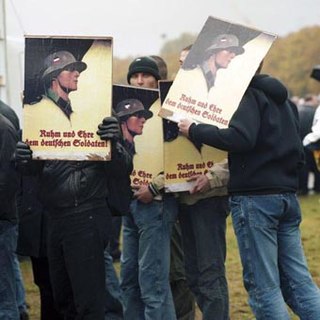 W
WThe Wehrmacht exhibition was a series of two exhibitions focusing on the war crimes of the Wehrmacht during World War II. The exhibitions were instrumental in furthering the understanding of the myth of the clean Wehrmacht in Germany. Both exhibitions were produced by the Hamburg Institute for Social Research; the first under the title "War of Annihilation. Crimes of the Wehrmacht 1941 to 1944", which opened in Hamburg on 5 March 1995 and travelled to 33 German and Austrian cities. It was the subject of a terrorist attack but the organizers nonetheless claimed it had been attended by 800,000 visitors. The second exhibition – which was first shown in Berlin in November 2001 – attempted to dissipate considerable controversy generated by the first exhibition according to the Institute.